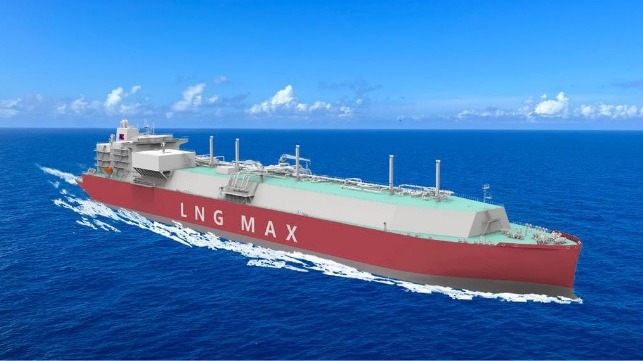China Designs World’s Largest LNG Carrier

China’s Hudong-Zhonghua Shipbuilding is presenting a new design concept for the world’s largest LNG carrier, created both to increase capacity as well as enhance operating efficiency. The design, which received Approval in Principle (AiP) from many of the leading class societies, comes as LNG transport is in high demand and producers such as Qatar and the U.S. are undertaking major expansions.
Qatar is adding its North Field to increase production which is also contributing to the record orderbook for new carriers. In the United States, several new export terminals are planned for the Gulf Coast. In addition, other U.S. facilities are expanding output to meet the growing import demand both from China and Europe.
The largest LNG carriers are Qatar’s Q-Max vessels which have a capacity of 266,000 cbm. Most of the vessels being built today are the conventional LNG carrier which has a capacity of 174,000 cbm. These have been viewed to be the most economical and versatile to operate and with the most effective gas containment and management systems.
The new design will expand LNG capacity by 57 percent over the conventional design with a capacity of 271,000 cbm. The vessels at 1,128 feet would be the same length as Qatar’s current largest ships. The American Bureau of Shipping, which was one of the class societies reviewing the design highlights that the vessel, which would have a 176-foot beam (molded) and 39-foot draft would be able to berth at 70 LNG terminals along the main trade routes.
The design was developed in part in a joint development project with DNV. The shipyard is reporting that in addition to ABS and DNV, it is also receiving AiPs from Lloyd’s Register and Bureau Veritas. They are promoting the receipt of the design approvals saying that it demonstrates that Hudong-Zhonghua can build innovative LNG vessels expanding on the 50 that they report are currently on order. Historically, the South Korean yards, which have 70 percent of the current orders for LNG carriers, have dominated this segment of shipbuilding.
To handle the LNG, the new vessel would transport the gas in five tanks. The newly designed tank would also be equipped with an enhanced cargo containment system together with a real-time sloshing monitoring system.
The vessel’s design also incorporates other elements not normally found on LNG carriers. ABS highlights a hull stress monitoring system and anti-collision technology. Other features that DNV is highlighting include air lubrication for the hull and a shaft generator. The design also incorporates selective catalytic reduction (SCR) that should reduce its nitrogen oxide (NOx) emissions, which will help the vessel comply with IMO Tier III controls even when in diesel mode.
Hudong-Zhonghua reports the ships will be dual-fuel to address emissions concerns. With a goal of creating a ship that is more efficient and economical, they are saying the new Global Max 271k type will have a 23 percent lower carbon intensity index (CII) than the conventional 174K LNG carrier widely deployed in the industry today.
The design will now undergo additional design and analysis work. Then the shipbuilder plans to present it to shipowners as a new option for LNG transport.
